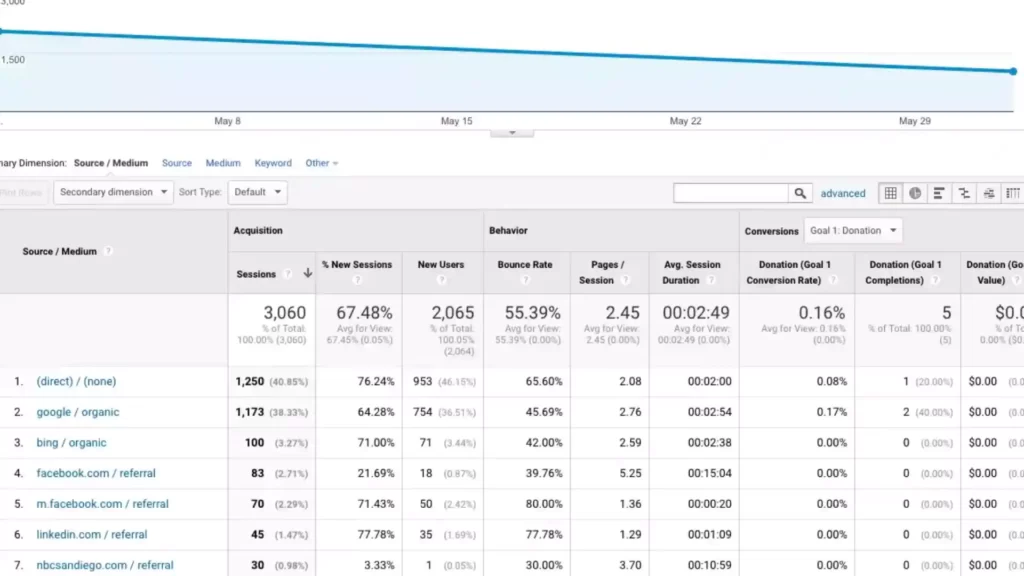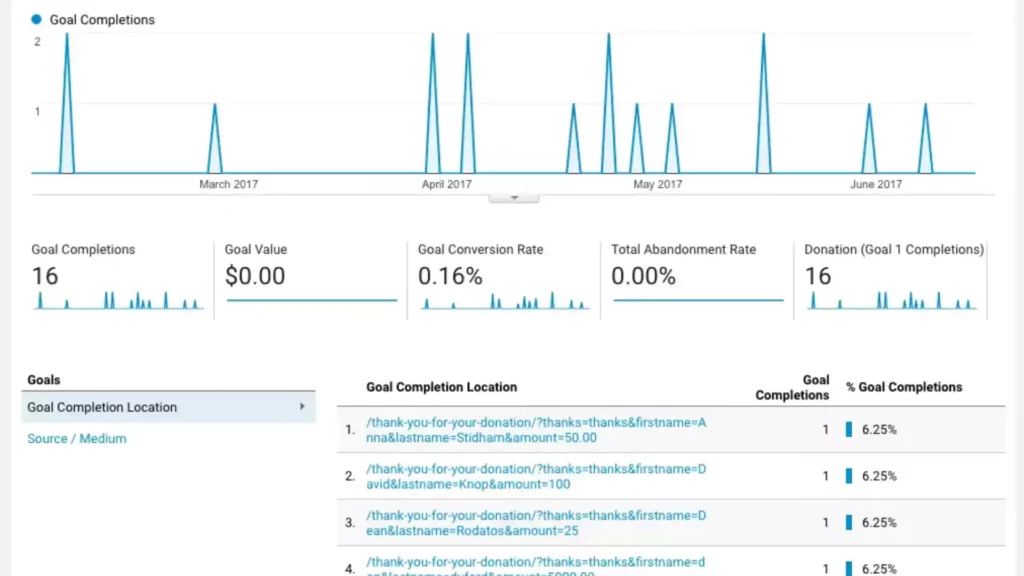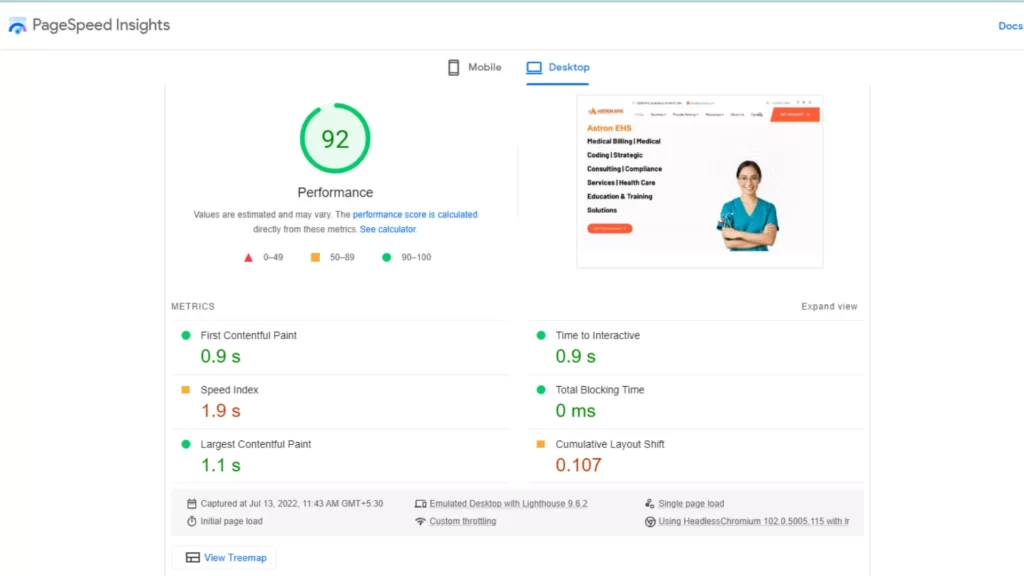Making Better SEO Reports for Your Clients: 7 Essentials
Making SEO reports for customers might be difficult. Here are the seven components every SEO report should have for your clients.
Making SEO reports for customers might be difficult.
Each customer or company has unique objectives. Depending on who is reading the report, your reports may need to be both simple and thorough.
However, SEO reports are essential. You must inform your customers, senior management, and other stakeholders of the success of your SEO operations.
What constitutes a “perfect” SEO report, then?
Here are the seven components of every SEO report for a customer must-have.
Traffic: Channels
Use the Source/Medium portion of the traffic report as well. It will provide you with more information about the source of the traffic, which will assist you to decide where to invest your time and money.
Other indicators may be significant, but it all depends on the business you’re dealing with.
A screenshot of the source/medium report is shown below:

Conversion Rate & Goal Completion
Even with all the traffic in the world, you won’t get very far if it doesn’t convert, which is what you want it to accomplish.
Conversion rate goes at the top of your SEO report because it is likely to be the measure that interests your clients the most.
Knowing the conversion rate will enable you to more clearly explain why the rest of the report is structured the way it is.
Goal monitoring is the most effective method for demonstrating conversion rate to a client.
For instance:

The aforementioned unnamed client established donation targets that they monitored each time a visitor arrived at the “thank-you-for-your-gift” webpage. This informed Google Analytics that a donation had been made, fulfilling the objective.
Page-Level Traffic
At this point, you may be aware of the origin of your visitors, but it’s crucial to understand their final destination.
It’s fantastic if someone found you through a Google organic search. But it’s much better if you know they found your most recent blog article.
This analysis will assist you in identifying patterns and determining what people are actually clicking on to drive traffic to your website.
Once more, it enables the client to determine whether they should invest more effort in optimizing their product page or whether they should possibly post more videos and less material.
Page Speed Insights
It’s time to switch from Google Analytics to Page Speed Insights, another excellent Google product.

This free tool will show your customers not just how quickly their pages load but also what has to be done to speed them up.
While this statistic may not have been as crucial in the past, a great user experience is now a requirement for SEO success.
A single image or video can significantly slow down a website. This tool may occasionally show crucial technological problems that are jeopardizing its SEO effectiveness.
Time on Site & Bounce Rate
Since these KPIs might not be absolutely, or positively required for the typical organization, this one is essentially just an “extra.”
You can determine whether the material you’re producing is “sticky” by looking at the time spent on the site and bounce rate.
However, pay attention to the websites that you are tracking for bounce rate and time on site. For instance, you generally don’t need to be concerned with time on site and bounce rate for a landing page. If you observe that customers leave it after 10 seconds but the landing page has numerous outbound links.
Rankings & Links
Although the majority of agencies and marketers continue to report on individual keyword rankings, there should be certain limitations.
It is foolish to use ranking information as the primary performance metric.
Google displays various results depending on the user’s history, customization, and location when conducting a search.
Tracking keyword placements still has some importance, but it should be a part of total performance reporting, not the only statistic.
Future Recommendations & Execution Plan
When you’re buried in data and reports, it’s probably not something you would ordinarily consider. but it’s crucial to include a part that demonstrates the consideration of your next course of action. Moving forward will be made possible by doing this.
Including a “recommendation” section at the end of each of the aforementioned sections of your report is the best thing you can do for your clients or senior management.
The only section of the report that will actually make your data usable is this one.
Our 4 Tips For Increasing The Effectiveness Of Your SEO Reports
Here are some insider tips on how to improve the effectiveness of your SEO reports. Make it simple for your clients to understand the value you add to their business.

Consult with your client about the report.
Despite the fact that templates specify what should be in your SEO report, you still need to figure out how to make your reports compelling, fascinating, and fun to read.
Keep in mind that the knowledge of your clients will range. As opposed to the reports you write for clients that don’t have a thorough understanding of SEO and best practices. If you work as a freelancer alongside an in-house team of experts, your SEO report should be more technical.
Having said that, waiting for your clients to respond after generating a report will not result in the desired outcomes.
Your customers have faith that the job you’ll do for them will help them expand their businesses. Their reservations, most of which won’t matter to you, though, temper this trust. As a result, after the report is turned in, you won’t have any influence over the decisions your customer makes after reading it.
They can start to question your level of experience and the calibre of your services if they find a result in your report that they don’t like. Imagine that you are not there to explain things and help them understand the significance of the material they are reading. In that situation, it’s unlikely that you’ll be able to persuade them to follow your advice.
Learn About the Past Site Optimization of Your Client
Finding out if any past optimization decisions have affected future site optimization efforts may sound like a common-sense approach, but what we’re talking about here goes beyond just performing a site audit.
Everything a new client did and planned for their website before you started working with them will have an effect on the work you do for them, either directly or indirectly, if you are an SEO freelancer.
Therefore, the quality of the SEO reports you deliver should be based on your familiarity with and comprehension of your client’s prior operations.
Consider learning when putting out your first report that your client has lost a sizable amount of the organic traffic they had been receiving. A drop in search visibility would be a logical conclusion, but you can’t entirely attribute it to this. You must provide precise advice on how to resolve the problem and an explanation of what brought about the decline.
Until you have a close look at what they did in the past to gain that traffic or keep it, or until you have access to SEO reports from companies they’ve employed in the past, you won’t really know what caused the loss of organic traffic. As a result, you could draw the wrong conclusions about the issue and propose unhelpful solutions. There are many reasons why search visibility could decline, including the following:
- Losing the links they have acquired.
- Google updates have an impact on their rankings.
- Competitors stepping up their SEO initiatives.
- They have a mobile-unfriendly website.
Explain How Your KPIs and Business Metrics Relate to One Another.
Your client’s primary interest in the report will be to learn how your SEO strategies are affecting conversions.
You should quantify the number of conversions and goals accomplished and create a link between your SEO efforts and conversions. The client consequently comprehends the true impact of SEO better.
For instance, adding items to a shopping cart, creating an account, and checking out are all common conversion goals in e-commerce. If you’re working with an e-commerce client, your report should show how SEO influenced the rise in these behaviours.
Have you changed the layout of the website to make it simpler for users to go between the checkout and product pages? If so, can you use a comparison of historical and present-day data to show how well your adjustments worked?
Don’t be scared to mention the successful actions you’ve taken in your report. Since not all of your SEO efforts will inevitably lead to sales, showing your clients how your efforts are moving leads down the sales funnel should be enough to convince them that you are providing value for money.
Conversely, if your data shows a decline in conversions and a target completion rate that is less than ideal, explain this to your client in your report. Sometimes, seasonality has an impact on conversions, especially in the e-commerce sector when holiday sales increase.
Additionally, to make a connection between your efforts and the outcomes you get, emphasize year-over-year fluctuations in conversions in situations where seasonality has an impact on conversions.
Online success requires careful planning and preparation; there is no quick fix.
It’s tempting to believe that everything is well and that creating reports would be simple when your SEO methods are working as intended. But as we both know, it’s not as common as you’d want for SEO strategies to produce home runs.
As a result, when creating your report, you should double-check that you’ve included all of the metrics that give a comprehensive picture of what’s happening on your client’s website. This will make your recommendations more pertinent and useful.
Different numbers will be generated when it comes to traffic, for instance, based on factors like the age of your blog posts, your brand, and the number of links your content has acquired, among others. You might assume everything is alright if your metrics look decent because older blog posts are more likely to gain visits.
But you’re interested in more than just traffic, right? Finding out what website visitors are doing is the first step if you want them to perform certain actions on your client’s website.
If you look a bit closer, you can see how website visitors act once they click on each blog post. It’s possible that you’ll come across one or more blog posts that get plenty of traffic but have high bounce and exit rates.
How to Get More Out of Your SEO Progress Report
What Should Be Included in an SEO Progress Report?

Whether you build your report as a document, a presentation, or a spreadsheet, it’s crucial to display all the pertinent data in an orderly manner. The fundamental components of your SEO report are listed below. You are free to add or modify the information as you see fit to meet the needs of your client.
Table of Contents
Establish the report’s content at the outset. Organize the chapter and sections so that your clients may easily see the report and jump to a particular section when necessary.
Summary
At the outset, give a summary of the entire report. It establishes expectations and takes into account the possibility that some of your clients—particularly the majority of business owners or executives—might not have the time to read the entire report.
Organic Traffic
One of the key driving forces behind SEO is this. To determine which pages are generating traffic and which are not, clients will need to see this. Just keep in mind to display the timeline so that they can see how the data changed over time.
You can use Google Search Console to view organic traffic from Google when using SEO tools to view this measure. Other search engines, like Yahoo and Bing, offer their own specialized tools that will display the information you require.
Ranking Summary
You must communicate this information to your clients as plainly as you can, as it is one of the most important aspects of an SEO strategy. Describe the keywords that your client is aiming to rank for, followed by an update on their progress. Your SEO keyword ranking report will be of great assistance from a keyword rank tracker. You will see the keyword position, search volume, monthly ranking trend, and more instantly.
In the long run, you’ll save time, effort, and money by using SEO software that has a keyword tracker that can target areas and allows you to add as many keywords as you need.
Links, Ranking Trends and Competition Analysis
You must have specialized SEO software or a dashboard as an SEO agency to track backlinks and other data. Other than via software or tool, there are no other means to gather data like backlinks and ranking. It will be more effective for you to deal with an SEO program that can supply all these data when you need them because you will be managing several clients and producing reports for them on a frequent basis.
Overall Traffic, Conversion, and Sales
The client will ultimately expect to see the outcomes of all campaign efforts, and it will all come down to these three elements.
- How much traffic did the website receive overall?
- The number of converts?
- How much money was made in sales?
Show your clients measurable results, such as the number of SEO leads that were found and the number that were converted. Your SEO agency’s efforts will be associated with successful outcomes, which will encourage them to continue working with you and increase their SEO spending.
The Seven Most Vital Inquiries to Ask About Your SEO Analytics
SEO is a technique that relies on objective data reporting and analysis to be effective; if you don’t listen to the data when it tells you that something is incorrect, you risk self-destruction. On the other hand, if you correctly interpret the evidence, you’ll all but ensure that your course of action is sound.

What are my goals?
Although you should have a general understanding of your objectives, it can be helpful to periodically review what your precise objectives are. Do you want to increase conversions? Are you only thinking about the traffic? What kind of traffic expansion did you anticipate? What sort of timeline were you considering? You can then design what you need to measure to assess your success in those key areas.
What progress am I making toward these goals?
Take a look at how the numbers depict your advancement toward your objective. Let’s imagine, for illustration purposes, that you anticipate a 50% rise in organic traffic over the first half of the year. How much of a traffic spike have you noticed after the first month? This is a simple issue, but one that’s frequently overlooked because people frequently ignore their ultimate goals in favour of their “progress” data.
How have things changed?
You should consider a number of different data points in this situation. Look for anomalies and deviations from the patterns you are accustomed to. A sudden increase in your bounce rate, for instance, or the popularity of one of your internal pages are both crucial indicators that one of your recent improvements is having an impact on user behaviour.
How is this different from what I expected?
Clarifying the gap between your real and expected outcomes can help you comprehend your SEO approach as a whole, thus it’s crucial. It requires you to question your presumptions and acknowledge that your theories about SEO development might be incorrect—something that most marketers are loathing to concede. Let’s imagine you recently started a new social media campaign, but the traffic to your social media pages didn’t increase as much as you had anticipated. Why is that so?
What qualities of this change are worth noting?
Look a little more at the primary changes in your report to identify any supporting characteristics that might be worth more consideration. Say, for illustration, that from one month to the next, your organic traffic significantly increased. What racial and ethnic groups are included in this organic growth? They will start with which pages. Do they behave differently than previous populations in your area did?
Why is this change occurring?
It can be challenging to identify the precise driver of a change in an SEO strategy, but it’s crucial that you make an effort. You shouldn’t just assume the first thing that comes to mind was the cause. For instance, if you introduce a new part of your content strategy and notice an increase in organic traffic, you might conclude your content strategy was to blame. It might be but look at other factors to find the true root reason.
What could I be missing?
This is a significant method to push oneself intellectually and is a difficult question to answer. Regularly reviewing your SEO approach will be beneficial. Consider all the data points, all the variables, and all the prospective changes that you might be overlooking. When you learn you’re mistake about something, you should be happy since it implies you have an opportunity to change.
